Octobers Beautiful Birthstone: The Opal
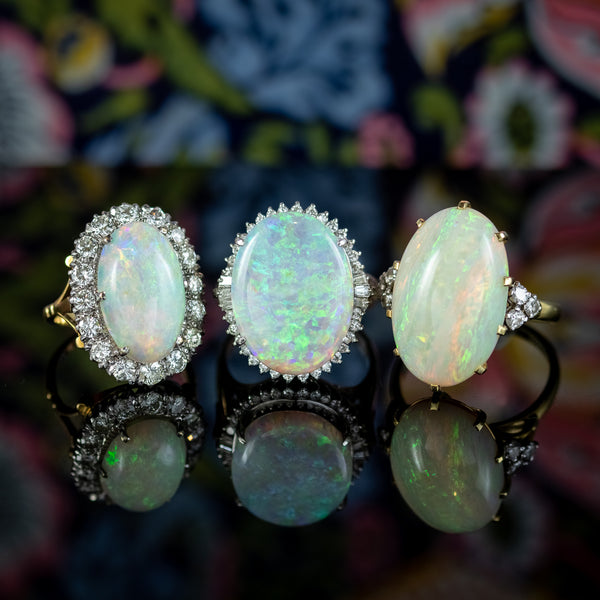
Opals are some of the most magnificent gemstones in existence, with an inner rainbow fire that is astounding to behold and has made them consistently popular in jewellery since time immemorial. At Laurelle Antique Jewellery we have had the pleasure of handling a great many of these wonderful gems and we’d like to share the benefit of our experience with you!
What is an Opal?
Like the vast majority of gemstones, opals are formed deep within the earth by a chemical process which takes millions of years. When water from the surface trickles down into the earth it can pick up silica from deposits of sedimentary rock such as sandstone. This moisture can then become trapped underground under extreme pressure as more layers of sediment build up above. Steadily the water evaporates and leaves behind the silica, which solidifies into opal.
There are many variations of this process, where slight changes in conditions can result in wildly different colourations and shapes.
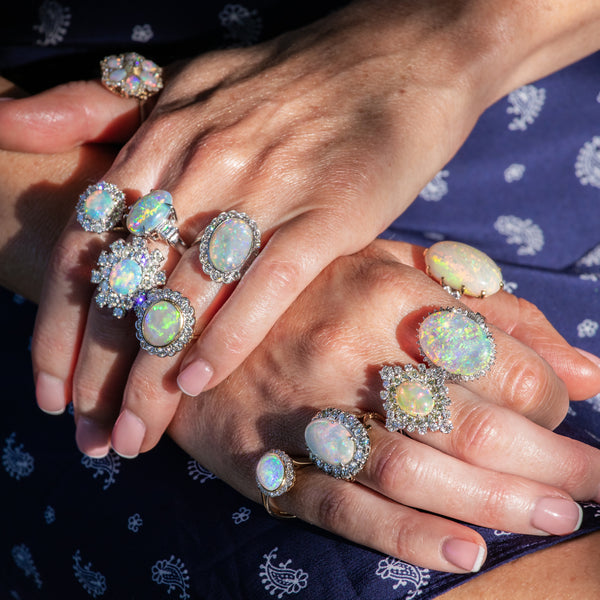
What is Opalescence?
Opals, like many gemstones, have a distinctive play of light through their surface which is caused by the way that the silica within them interacts with light. In these stones the effect is so unique that it is named after the stone itself. Opalescence causes the light within the opal to be split into an array of different colours. The play of light within many gemstones is called “fire”, but in opals this is most appropriate as the gemstone seems to truly be alight from within, and when the stone is moved the flames flicker as though it burns.
Types of Opals
Although all opals are rare the most common are often referred to as “white opals” after the grey/white base colour they exhibit. The other varieties of opal are so rarely seen that many people are completely unaware of them, so white opals are often simply known as opals.
Jelly opals, also known as water opals, are so called because they have a greater degree of transparency, which makes them appear like droplets of a gelatinous substance. They can vary in colour and hue, and the label is not exclusive, so it is possible to have black and fire opals which could also reasonably be labelled as jelly opals.

Black opals have a much deeper base colour than white opals, which makes the fire within stand out a great deal more in contrast. The fire colours can also be quite different from other opal forms, with each stone having a completely unique form of opalescence that makes them substantially more valuable than more standardised opals.

Fire opals have a bright orange base colour that accentuates the interplay of light within and makes them appear to be truly aflame. Most opals are cut en cabochon, meaning that they have a smooth dome on top and a flat base. This cut works extremely well for most types of opal, but fire opals often have a more subdued within that can benefit from faceted cut commonly used with other gemstones
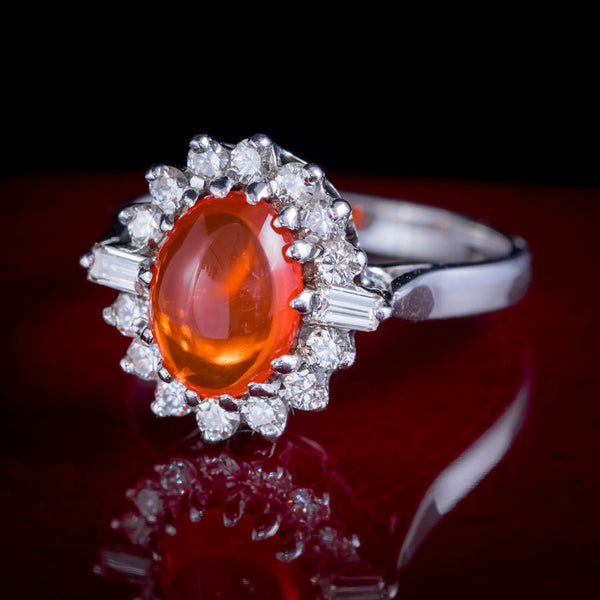
Both boulder opals and matrix opals consist of opal which is still inlaid with a substantial amount of the host rock. Such opals can’t be separated from the host rock without damaging them, but they are no less remarkable for this fact. This type of opal is most often used as an interesting ornament or geological specimen rather than in jewellery.
It is possible to manufacture opals in a laboratory, although these “cultured” opals differ considerably from naturally formed opals. They are often more porous and less dense, which means they are more prone to damage than true opals. They are also relatively easy to distinguish from natural opals as their fire is confined to multiple grainy patches within the stone, rather than the sweeping nebulous patterns of a true opal. Although cultured opals are beautiful they pale in comparison to their natural cousins.
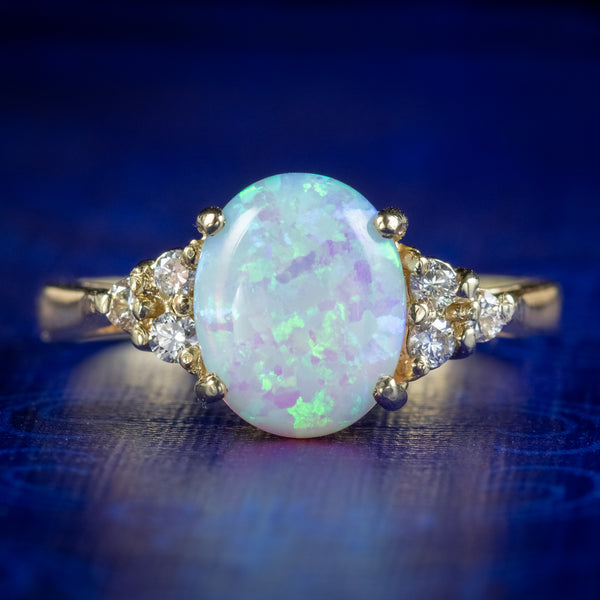
Where are Opals Found?
Opals are found in both the United States and Mexico, but the largest amounts have historically been found in Australia – a fact that has led to the opal becoming the country’s national stone.
These gemstone reserves are due in large part to the conditions which created the Great Artesian Basin, which underlies around 22% of the continent, a staggering 1.7 million square kilometers. Large bodies of water once sat on the surface of what is now a dry bed of sedimentary rock, making it ideal for opal formation. The south Australian regions of Amooka and Coober Pedy are the most famous producers of opal.
Opal Lore
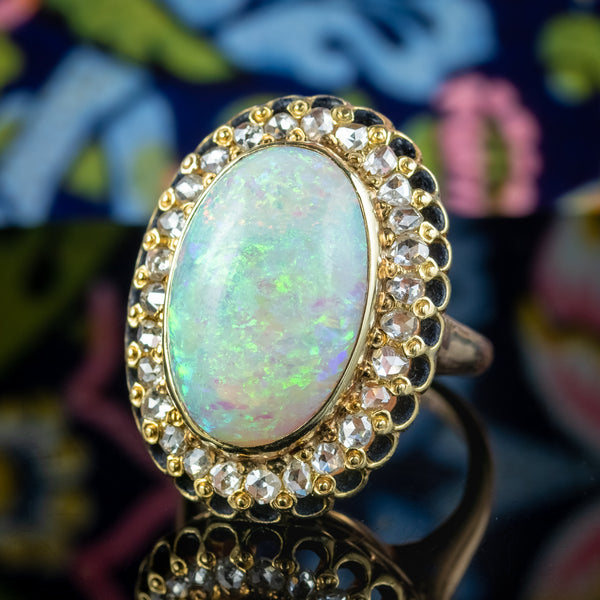
Opal is the birthstone for the month of October, and has also become associated with the 24th wedding anniversary.
Strangely opals have a persistent reputation as bearers of misfortune, but this is a very recent development. Prior to the Victorian era they were actually considered lucky for many centuries. The origin of the negative superstition with opals is the popular novel Anne of Geierstein by Sir Walter Scott published during Queen Victoria’s reign. In this book the opal has a strong involvement with the death of one of the main characters.
In ancient Greek mythology opals were believes to have been formed from the calcified tears of the god Zeus. In order to become king of the gods Zeus was forced to fight and defeat his father Cronus, the leader of the pre-Olympian deities known as the Titans, and to rescue his brothers and sisters from the titan’s stomach after he had devoured them to prevent them usurping him.
This association makes sense, as opals can appear to be almost liquid, and their fire could be said to be similar to the lightning for which Zeus is so famed. Their colours also inspired association with the Indian goddess of rainbows, who was said to have transformed herself into the precious stone to escape a surfeit of male suitors. This led to the opal becoming associated with both purity and innocence.
Antique Opal Jewellery

Opal has been worked into many forms of jewellery since ancient times, and some truly remarkable pieces of vintage and antique opal jewellery can still be found today. The value of these stones means that antique opal rings, pendants, bracelets and earrings were worked by extremely skilled jewellers. These artisans combined elaborately worked precious metals and other gemstones, particularly diamonds, to create wonderful items which are just as beautiful today as when they were first forged.
At Laurelle Antique Jewellery we have spent many years tracking down beautiful opal jewellery from the Georgian, Victorian, Edwardian and Art Deco periods.
You can view our full collection of antique opal jewellery here. View our complete collection of opal rings, or is you are looking for antique opal rings or vintage opal rings, we are sure to have something in our store for you.
If you have any questions about the pieces which we sell feel free to get in touch on England: 0333 700 4500 or send us an email via enquiries@antiquejewellerygroup.com. Our team is always happy to help!



